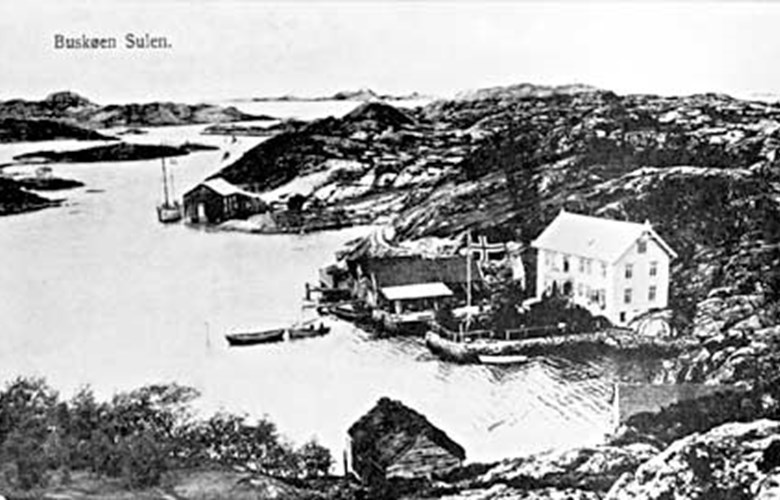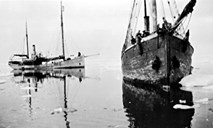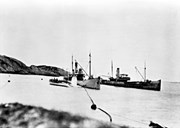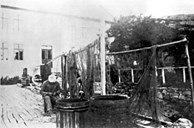Big business at Buskøy
The Hess name came to Buskøy in 1849, with the sailing-ship captain Hans Hess. He was from Lübeck in Germany, arrived from Bergen with his family, and bought the place. Hans Hess died the year after, and the place was sold. But his son, the enterprising Georg Balchen Hess, married a girl from Buskøy and spent many years there. He operated the farm, the general store, the bakery, bought and exported lobster and salmon, salted herring, and brewed beer, which he served in the "borgarstova" (large house). He owned half of the seines at Buskøyvågen and was the natural boss. In 1878, a post office was opened, and a telephone exchange in 1910, both among the first in Solund.
"Borgarstova" is replaced by "sveitserhus" (house built in Swiss style)
In 1888, he had the old, beautiful "borgarstova" torn down, which made room for the new, big "sveitserhus", which still stands. There was an open veranda with a balcony on top, with expensive carvings, which could not be maintained and were later removed. The building contained a post office, a general store, had living rooms, a kitchen, rooms for the servants, etc., on the ground floor. On the first floor, there were eight rooms, most of them residential, and there were several bedrooms in the attic.
Shortly after the turn of the century, he had a new, modern cowshed built. The farmland was split up and difficult to cultivate, yet was worked to capacity. An ice shed was built, where they stored ice which was cut in a lake nearby.
Herring and Greenland seal
His son, Jan Hess, who lived in the house with his family, did not himself operate Buskøy as his father had done. Yet he in his time would sell and buy more than most people.
Jan Hess grew up in a period of promising herring fisheries. The ocean silver became one basis, and the Greenland seal the other, of Jan's business. He began in an open sailing-ship, but at twenty, he already owned half of a 36-foot vessel which operated in the waters off Sunnmøre. Soon he bought a larger vessel of his own. Jan was well versed in the technical development in the fisheries. The company Haldorsen at Rubbestadneset in Sunnhordland made Rubb motor no. 2 for Hess, with four HP.
Seal hunter with sails
To finance new equipment, Jan established a company in which people with capital could buy shares. In this way, he was able to order the 81-foot-long steamer "Solunder" in 1902. Some of the crew owned shares. The boat went fishing on the shoals and for fat herring. He was uneasy that everybody would not be able to vote, so he let the "Solunder" pick up voters in Solund for the referendum on the dissolution of the union with Sweden in 1905.
Hess hired captains and engineers. He sold the "Solunder" and bought the steamship "Olga", and soon after, he acquired the first sealer, the sailing-ship "Polarstrømmen". This was in a joint ownership with Lyder Strømmen, who operated the boat and hunted well. Jan and Lyder later owned several boats together.
Setbacks in the 1920s and 1930s
He owned one steamship after the other, for herring fishing, seal hunting, etc.. A large sea warehouse in two storeys was built, which gave room for equipment. The fisheries were at their peak around the First World War, but the cyclical downturn caused by the war ruined the business. Large quantities of herring could not be sold. Hess reduced his activities, but owned boats until well into the 1930s.
In 1918, Jan had moved his business to Florvåg in Hordaland, where he together with his son-in-law built up an extensive business with houses, quays, and boats. In 1932, he moved back to Buskøy and was active almost to his death in 1946. Even today members of the Hess family open the door of the general store in the "sveitserhus" at Buskøy.





